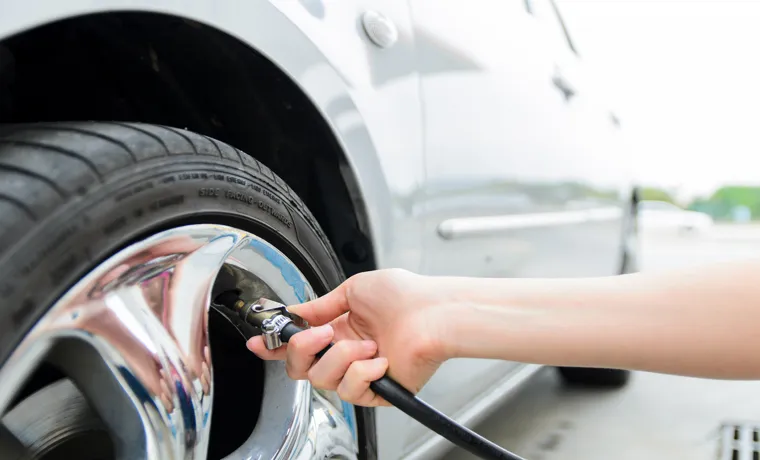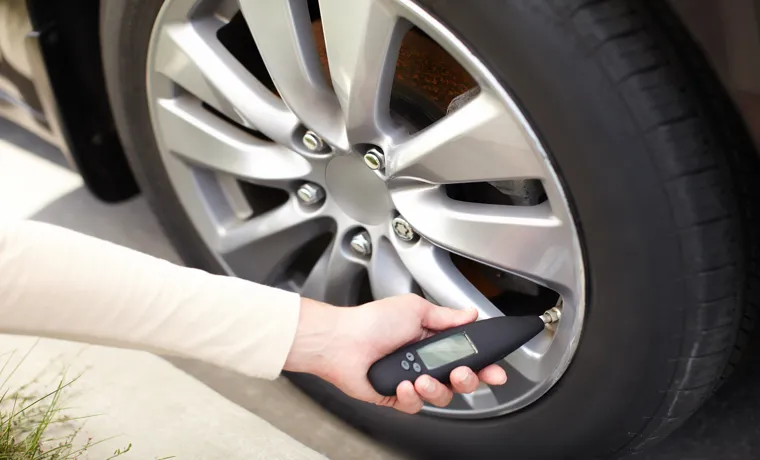When was the last time you checked the pressure of your spare tire? If you can’t remember, then it’s probably time to give it some attention. Your spare tire might not be used often, but it’s essential to ensure it’s in good condition and ready to use when needed. Tire pressure can affect your car’s handling, fuel efficiency, and overall safety.
So, in this blog, we’ll discuss how often you should check tire pressure in your spare tire and why it’s important to do so regularly. Let’s get started!
Importance of Checking Spare Tire Pressure
When it comes to checking tire pressure, most of us only think about the four tires that are currently supporting our vehicle. However, it’s important to remember that there is also a spare tire hanging out in the trunk or underneath the car. But how often should you check the tire pressure in your spare tire? Experts recommend checking all tires, including the spare, at least once a month, or before a long road trip.
The spare tire is your backup in case of a flat or blowout, so it’s crucial that it’s in good condition and properly inflated. Not checking the spare tire pressure can lead to a flat spare tire when you need it most, leaving you stranded on the side of the road. So, take the time to check your spare tire pressure and make sure it’s ready to take over if necessary.
Keeping Your Spare Tire in Optimal Condition
One thing that we often neglect when it comes to vehicle maintenance is checking the spare tire. We often assume that since it is not being used, it is in excellent condition. However, this is not always the case.
It is essential to check the spare tire’s pressure regularly to ensure it is in optimal condition. The spare tire’s pressure should be the same as the other tires. Having a flat spare tire defeats its purpose and could leave you stranded.
Inspect the tire’s condition as well, making sure there is no significant damage or wear. Keep in mind that the spare tire may have been in your trunk for years, so do not overlook its age. Even if it looks brand new, if it’s been in the trunk for more than six years, it’s wise to replace it.
Checking the spare tire pressure might seem like a small thing, but it could make all the difference in an emergency. Always be prepared and proactive with your vehicle maintenance.

The Effects of Neglecting Your Spare Tire
When it comes to car maintenance, many people forget to check the pressure of their spare tire. This can be a big mistake in the event of a flat tire, as a neglected spare tire could cause further problems. Having a properly inflated spare tire can be the difference between a minor inconvenience and a major issue.
It’s important to remember that neglecting your spare tire could lead to decreased control of your vehicle, decreased fuel economy, and even a flat spare tire when you need it most. Checking your spare tire pressure regularly is an easy task that can save you from a big headache down the road. Don’t let a neglected spare tire steer you off course – take the time to keep it in check.
Recommended Spare Tire Pressure Check Frequency
If you have ever found yourself on the side of the road with a flat tire, you know how important it is to have a spare tire that is properly inflated. But how often should you check the pressure in your spare tire? Experts recommend checking your spare tire pressure at least once a month. This is because spare tires are often forgotten about and can lose pressure over time, which can leave you stranded in an emergency.
Additionally, some spare tires are stored in locations that are affected by temperature changes, which can also affect the tire pressure. Keeping your spare tire properly inflated and in good condition can ensure that you are prepared for any unexpected tire emergencies that may arise. So make it a habit to check your spare tire pressure regularly to ensure you are prepared for any situation on the road.
Manufacturer’s Guidelines
As a responsible driver, it is important to follow the manufacturer’s guidelines when it comes to maintaining your spare tire. One of the most crucial aspects of spare tire maintenance is regular pressure checks. The recommended frequency for this may vary depending on the specific make and model of your vehicle, so it’s important to consult your owner’s manual for the manufacturer’s recommendations.
However, a general rule of thumb is to check the spare tire’s pressure every six months, or more frequently if you frequently drive on rough terrain or in extreme weather conditions. Keeping your spare tire properly inflated not only ensures that it will be ready for use in an emergency, but it can also extend the overall lifespan of the tire. Don’t wait until it’s too late – make sure you stay on top of your spare tire pressure checks to stay safe on the road.
Vehicle Usage Frequency
When it comes to maintaining the safety of your vehicle, checking the tire pressure is absolutely vital. The recommended frequency of spare tire pressure checks depends on your vehicle usage. If you use your vehicle frequently and for long periods of time, it’s a good idea to check the spare tire pressure once a month.
This is especially important if you frequently drive on rough terrain or erratic weather conditions. On the other hand, if you use your vehicle sparingly, such as for short commutes or occasional road trips, checking the tire pressure every 3-6 months is sufficient. It’s important to remember that neglecting to check tire pressure can have dire consequences, including reduced fuel efficiency, uneven tire wear, and even accidents caused by blowouts.
Don’t overlook the importance of maintenance for your spare tire, as it can save you time, money, and even your life in the long run.
Seasonal Changes
As the seasons change, so should your vehicle’s tire pressure. Proper tire pressure is crucial for maintaining your vehicle’s handling, fuel efficiency, and overall safety. The recommended spare tire pressure check frequency is about once a month, but it’s especially important to check during seasonal transitions.
When the temperature drops in the winter, tire pressure can drop as well. Low tire pressure leads to decreased traction on icy or wet roads. On the other hand, during the hot summer months, high temperatures can cause your tires to expand and potentially blow out.
By checking your tire pressure regularly, you can avoid these safety hazards and ensure your vehicle is running smoothly. Remember, a few minutes spent checking your tire pressure can save you a lot of trouble down the road!
How to Check Your Spare Tire Pressure
As a responsible driver, it’s important to check the pressure of your spare tire regularly, because when you need it, you don’t want to be caught with a flat. In addition, checking your spare tire’s pressure is just as important as checking the pressure in your regular tires. Experts recommend checking your spare tire’s pressure at least once a month, and that’s especially true when you’re approaching a long trip.
Your spare tire pressure should match the pressure in your other tires, which means you should be checking the manufacturer’s recommendation. To check your spare tire pressure, you can use a tire pressure gauge or take your vehicle to a professional for an inspection. By following these simple tips, you can help ensure that your spare tire is ready to go when you need it most.
Tools Required
Checking your spare tire pressure is an essential safety measure that every driver should take seriously. The last thing you want to experience on the road is a flat tire, let alone a spare that’s also flat. So, to avoid this, you’ll need the appropriate tools to check the pressure on your spare tire.
You’ll need a tire pressure gauge, which is a small and inexpensive tool that can help you determine your tire’s pressure. Ensure that the spare tire pressure is within the recommended levels, and if it’s not, use an air compressor to fill it up. Don’t forget to also check for any punctures or damages that may cause a failure in the future.
With the proper tools and a few extra minutes, you can ensure that your spare tire is always ready to go in case of an emergency. Remember, keeping your spare tire in good condition is crucial for your safety on the road.
Step-by-Step Guide
Checking your spare tire pressure is an essential aspect of vehicle maintenance that is often overlooked. Knowing how to check your spare tire pressure is crucial, as it can help you avoid being stranded in the event of a flat tire. The first step is to locate your spare tire, which is usually located in the trunk of your car.
Next, remove the valve cap from the tire valve stem. You can use a tire gauge to measure the air pressure in the tire. The recommended psi for your spare tire is usually listed in your owner’s manual or the tire itself.
If the pressure is too low, use an air compressor to inflate the tire. Once you have inflated the tire, replace the valve cap and stow the tire back in its proper place. Remember to check your spare tire pressure regularly, especially before a long trip, to avoid any unnecessary setbacks on the road.
Conclusion
So, how often should you check tire pressure in your spare tire? Well, as with all things in life, it’s better to be safe than sorry. While you may not use your spare tire often, it’s important to check it periodically to ensure that it’s in good shape and ready to use in case of an emergency. So, don’t neglect your spare tire – give it a little love and attention every once in a while, and it’ll be sure to repay you when you need it most.
“
FAQs
Why is it important to check tire pressure in your spare tire?
It’s important to maintain proper tire pressure in your spare tire to ensure it’s ready for use in case of an emergency.
How often should you check the tire pressure in your spare tire?
It’s recommended to check the tire pressure in your spare tire at least once a month or before long trips.
What is the ideal tire pressure for a spare tire?
The ideal tire pressure for a spare tire is usually indicated in your vehicle’s owner manual or on the tire itself. It’s important to maintain the recommended pressure.
Can you use a spare tire with low pressure?
While you can use a spare tire with low pressure in an emergency, it’s important to inflate it to the recommended pressure as soon as possible.
How long can you drive on a spare tire?
It’s recommended to drive on a spare tire for no more than 50 to 70 miles and at a speed no higher than 50 mph. It’s meant to be a temporary fix until you can replace the tire.
Do all vehicles come with a spare tire?
No, not all vehicles come with a spare tire. Some vehicles come equipped with run-flat tires, while others may come with a tire repair kit.
How do you properly store a spare tire?
A spare tire should be stored in a cool, dry place away from direct sunlight and sources of heat. It should also be kept away from flammable liquids and gases.

